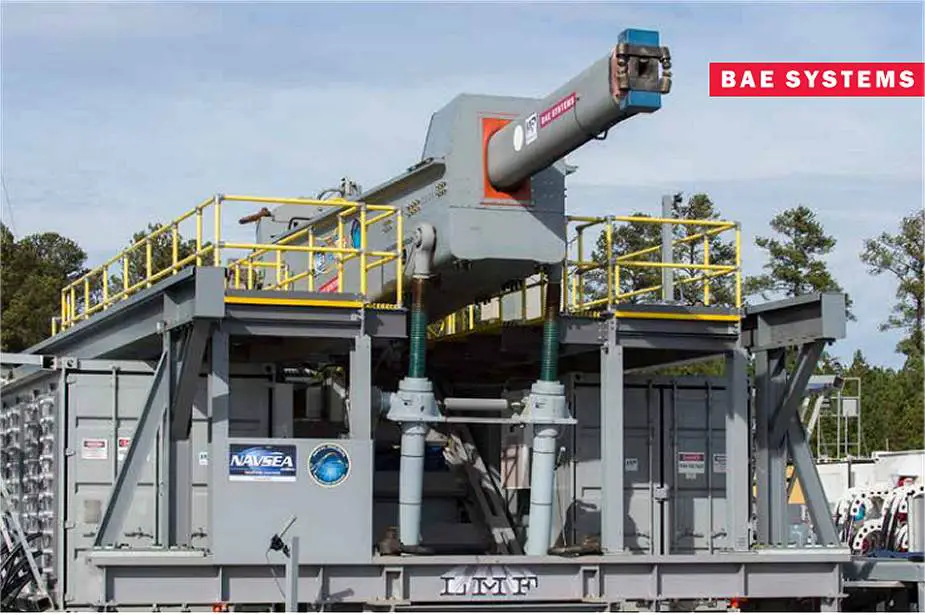US Navy to develop three new ship-based laser weapons to counter new aerial threats
According to a report published by the United States Congress on October 15, 2020, three new ship-based laser weapons being developed by the U.S. Nav including the Solid-State Lasers (SSLs), the ElectroMagnetic RailGun (EMRG), and the Gun-Launched Guided Projectile (GLGP), also known as the hypervelocity projectile (HVP)—could substantially improve the ability of U.S. Navy surface ships to defend themselves against surface craft, unmanned aerial vehicles (UAVs), and eventually anti-ship cruise missiles (ASCMs).
Follow Navy Recognition on Google News at this link
 U.S. Navy USS Portland (LPD 27) conducts a Solid State Laser - Technology Maturation Laser Weapon System Demonstrator (LWSD) test in the Pacific, May 16, 2020. (Picture source U.S. Navy)
U.S. Navy USS Portland (LPD 27) conducts a Solid State Laser - Technology Maturation Laser Weapon System Demonstrator (LWSD) test in the Pacific, May 16, 2020. (Picture source U.S. Navy)
The U.S. Navy in recent years has leveraged both significant advancements in industrial SSLs and decades of research and development work on military lasers done by other parts of DOD to make substantial progress toward deploying high-energy SSLs on Navy surface ships.11 Navy surface ships would use high-energy SSLs initially for jamming or confusing (i.e., “dazzling”) intelligence, surveillance, and reconnaissance (ISR) sensors, for countering small boats and UAVs, and potentially in the future for countering enemy missiles as well. High-energy SSLs on Navy ships would generally be short-range defensive weapons—they would generally counter targets at ranges of about one mile to perhaps eventually a few miles.
Between 2009 and 2012, the US. Navy successfully tested a prototype SSL called the Laser Weapon System (LaWS) against UAVs in a series of engagements that took place initially on land and subsequently on a Navy ship at sea. LaWS had a reported beam power of 30 kilowatts (kW).
The LaWs or AN/SEQ-3 Laser Weapon System is a laser weapon developed by the United States Navy. The weapon was installed on USS Ponce for field testing in 2014. In December 2014, the United States Navy reported that the LaWS system worked perfectly against low-end asymmetric threats and that the commander of Ponce is authorized to use the system as a defensive weapon. The exact level of power the LaWS will use is unknown but estimated between 15–50 kW for engaging small aircraft and high-speed boats.
In May 2020, The U.S. Navy amphibious transport dock ship USS Portland successfully disabled an unmanned aerial vehicle on May 16 with a Solid-State Laser — Technology Maturation Laser Weapon System Demonstrator (LWSD).
The U.S. Navy is currently developing SSLs with improved capability for countering surface craft and UAVs, and eventually a capability for countering ASCMs. Navy efforts to develop these more-capable lasers including the Solid-State Laser Technology Maturation (SSL-TM), the Surface Navy Laser Weapon System (SNLWS) Increment 1, also known as the high-energy laser with integrated optical dazzler and surveillance (HELIOS), and the High Energy Laser Counter-ASCM Program (HELCAP).

BAE Systems Electromagnetic Railgun uses electromagnetic force to launch high-velocity projectiles. (Picture source BAE Systems)
The U.S. Navy since 2005 has been developing EMRG, a cannon that uses electricity rather than chemical propellants (i.e., gunpowder charges) to fire a projectile.43 In EMRG, “magnetic fields created by high electrical currents accelerate a sliding metal conductor, or armature, between two rails to launch projectiles at [speeds of] 4,500 mph to 5,600 mph,”44 or roughly Mach 5.9 to Mach 7.4 at sea level.45 Like SSLs, EMRG draws its power from the ship’s overall electrical supply
The Electromagnetic Railgun (EM Railgun) is an advanced containment technology demonstrator, capable of 32 Megajoules (MJs) of muzzle energy. In conjunction with the EM Railgun, hypersonic projectiles and pulse forming networks for power generation are also being researched and developed.
When fully weaponized, the EM Railgun will deliver hypervelocity projectiles in support of U.S. Marines, ground forces, and ship defense. The EM Railgun technology uses high-power electromagnetic energy instead of explosive chemical propellants (energetics) to propel a projectile farther and faster than any preceding gun. At full capability, the EM Railgun mounted on U.S. naval vessels will be able to fire a projectile 100 nautical miles at a muzzle velocity up to Mach 7.5 and impacting the target at Mach 5. The high-velocity projectile will destroy land, sea, and air targets due to its kinetic energy, rather than with conventional explosives.
The safety aspect of the railgun is one of the greatest potential advantages of the EM Railgun. No propellant is required to fire the projectile, and no explosive rounds are stored in the ship’s magazine. The EM Railgun represents significant advances in U.S. Navy and Marine Corps capabilities, extends the range of U.S. Marine Corps combat capability and distributed operations, as well as improves safety aboard surface ships.
As the U.S. Navy was developing EMRG, it realized that the guided projectile being developed for EMRG, which weighs about 28 pounds,55 could also be fired from 5-inch and 155 mm powder guns. When fired from EMRG, the projectile reaches hypervelocity (i.e., Mach 5+) speeds, and thus came to be known as the hypervelocity projectile (HVP).
When fired from a power gun, the projectile flies quickly, but not as quickly as it does when fired from EMRG. In addition, whereas the Navy’s original concept was to use the EMRG projectile for both EMRG and powder guns—and might still decide to do that—the Navy now states that the high-speed projectile fired from powder guns might instead be a different projectile. For both of these reasons, the high-speed projectile for powder guns, which was originally called HVP, is now referred to by the Navy as the Gun-Launched Guided Projectile (GLGP).
Cannon-launched guided projectiles are precision-guided munitions launched by conventional tube artillery and guns. Cannon Launched Guided Projectiles commonly referred to by the abbreviation CLGP are intended to supplement and not supplant conventional rounds, providing additional accuracy when needed.

BAE Systems Guided Projectile for Railgun (Picture source Navy Recognition)


























